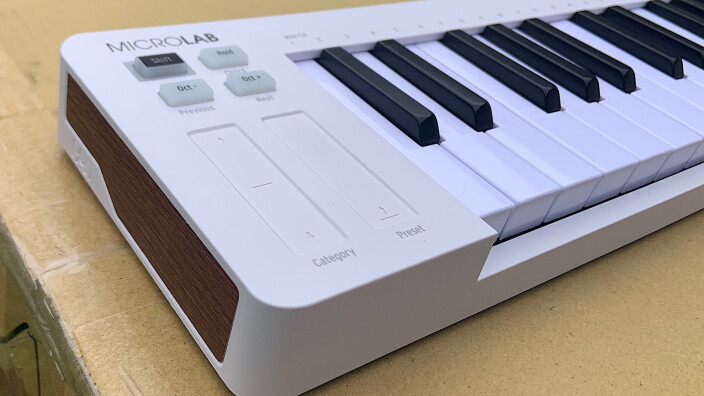In the face of increasingly active competition, Arturia is not resting on its laurels and unveils the new version of its MicroLab. What's in store for this little controller keyboard, designed to take you everywhere?

As we all know, musicians, producers and beatmakers are increasingly looking for compact, easy-to-transport solutions for their production tools. Keyboard controllers are no exception to this trend. Whether for a cluttered or small home studio, or for a musician on the move, such keyboards have become indispensable tools.
And for good reason: they find their place in many situations and adapt to a wide variety of profiles. Whether it’s a composer looking to quickly lay down a few harmonic ideas, a beatmaker wanting to drive his DAW and trigger loops, or a guitarist looking to round out his setup with a little extra keyboard, the uses are many.
On one condition, of course, one must have a computer or tablet. We’re not talking about controlling hardware here. And while more and more instruments today incorporate a USB connection in addition to, or even in place of, traditional MIDI sockets, that’s simply not what MicroLab is about.
A reworked design and minimalist connectivity for the MicroLab Mk3

We note the disappearance of the famous rubber “bumper”, which also acted as storage for the USB cable. This is all the more regrettable as this element, in addition to providing an original aesthetic touch and a bit of fun, proved to be very practical in use.
The format remains as compact as ever. At 406 × 125 × 39.3 mm (15.9 × 4.9 × 1.5 inches) and weighing 0.6 kg (1.3 lbs), it’s perfect for a train or plane tablet, and easy to slip into a backpack. On the other hand, lacking the rubber protection, the MicroLab Mk3 seems a little more exposed to the vagaries of transport.

While, in the previous version, Arturia boasted about the lateral placement of connectivity, thought to optimize space when a laptop is placed right behind, it’s now relegated to the rear. Connectivity remains minimalist, but consistent with the philosophy and price of the MicroLab Mk3: a USB-C port (cable supplied) for power and MIDI transmission, plus an assignable jack socket for a pedalboard (sustain or other MIDI controller CC). In reality, few users will carry a pedal with them, but this option has the merit of existing.
MicroLab Mk3: controls, keyboard playing and software bundle included

Nice little trick: the Octave buttons, combined with the Shift key, let you navigate through Analog Lab presets (the Intro version is included) using the “Previous” and “Next” functions. It’s really handy, but we wonder why this feature hasn’t been extended to all the brand’s software. Too bad!
The Hold button acts as a sustain pedal, maintaining the notes played even after the keys have been released. Combined with Shift, it activates Chord mode, handy for playing chords with a single finger.
To the left of the keyboard, the two tactile strips are used for pitch bend and modulation. A pleasant surprise here: the central area of the pitch strip is well calibrated, avoiding the little unintentional shifts sometimes found on competitors.
On the keyboard side, there are 25 velocity-sensitive slim keys, taken directly from the MiniLab 3. And frankly, you can feel it: the touch is pleasant, responsive, and more than enough for composing on the fly or playing simple games. We’re not talking here about a keyboard designed for complex expressive parts, but for throwing ideas around quickly or driving a little live setup, it’s perfect.
Finally, MIDI channel selection is made, as is often the case with Arturia, via the first 16 keys of the keyboard, by holding down Shift.

Certainly, the bundle may seem a little minimalist, but, given the greatly reduced price and the overall quality of the product, it’s hard to complain. Besides, the direct competition doesn’t do much better in this respect.
Also worth noting : MIDI Control Center is included. This little piece of software lets you configure certain MicroLab Mk3 functions from a computer : velocity curve, pedal behavior, and so on. It’s not ultra advanced, but sufficient to adapt the keyboard to your playing or setup.
FAQ
Is the MicroLab Mk3 compatible with hardware synths?
No. This is a controller keyboard designed to drive software via USB. It has no MIDI DIN output.
Can the MicroLab Mk3 be powered by a tablet?
Yes, via USB-C. It works equally well with a computer or a USB-compatible tablet.
Is there internal memory for presets?
No, everything is done in conjunction with the software. The keyboard does not save presets internally.
What are the differences with MiniLab 3?
The MiniLab 3 is more complete with more physical controls, a screen, an arpeggiator. The MicroLab Mk3 is more compact and minimalist.
Can I connect an expression pedal?
Yes, an assignable jack input is provided, but nomadic use limits its practical value.
Specifications
-
25 velocity-sensitive slim keys (from MiniLab 3)
-
4 buttons : Octave +/-, Hold, Chord
-
2 touch bands: pitch bend and modulation
-
USB-C port (power and MIDI)
-
Assignable jack socket for pedal (sustain or MIDI CC)
-
Dimensions : 406 × 125 × 39.3 mm (15.9 × 4.9 × 1.5 inches)
-
Weight: 0.6 kg (1.3 lbs)
-
Software bundle: Analog Lab Intro, Ableton Live Lite
-
Compatible with Mac, Windows and selected USB-C tablets
-
Configuration via MIDI Control Center software
-
Made in China
